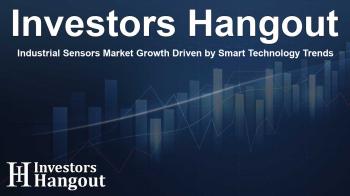Industrial Sensors Market Growth Driven by Smart Technology Trends

Significant Growth in the Industrial Sensors Market
The industrial sensors market is poised for substantial growth, projected to increase by USD 14.3 billion from 2024 to 2028. This expansion is largely driven by the rising demand for automated systems and smart factories, as industries recognize the benefits of utilizing advanced technologies. This modern technological landscape underlines a wider shift towards the Industrial Internet of Things (IIoT), allowing enhanced efficiency and real-time data processing.
Market Trends Shaping the Industry
One of the primary trends fueling the growth of the industrial sensors market is the transformation towards smart factories. As industries adopt IIoT technologies, the need for various sensors has skyrocketed, particularly those monitoring operational conditions remotely. This demand for seamless monitoring and integration of machinery highlights the increasing reliance on sensors like pressure, temperature, and proximity sensors. Furthermore, the emphasis on predictive maintenance and uptime optimization showcases a shift in how manufacturers approach operational efficiency.
Challenges Impacting Market Growth
Despite the optimistic outlook, the market faces challenges, particularly in balancing quality and cost-effectiveness. Many players in the industry struggle to deliver advanced sensing technologies while keeping prices competitive. The cost associated with custom sensors can deter potential clients, although off-the-shelf options have become more accessible. Companies must navigate these economic pressures while fostering innovation to meet the diverse needs of their clientele.
The Role of AI in Market Evolution
Artificial intelligence plays a pivotal role in driving market change, enabling smarter and more adaptive sensor systems. AI-driven analytics allow for effective data processing, leading to improved operational decisions for various sectors including manufacturing and energy. By integrating machine learning algorithms, industries can leverage predictive maintenance strategies, ensuring maximized performance and minimized downtime.
Market Segment Breakdown
The industrial sensors market can be segmented into categories based on end-users, products, and geographical reach. The end-user segments include process industries such as oil and gas, food and beverage, and pharmaceuticals, along with discrete industries. Product types span across pressure, temperature, proximity, flow sensors, and others, catering to specific industrial needs. Geographic segmentation further defines market opportunities, taking into account regional demands for sensors in various applications.
Importance of Advanced Sensing Technologies
Advanced sensing technologies are becoming increasingly integral in ensuring the smooth operation of various industries. Sectors like renewable energy, manufacturing, and logistics are rapidly adopting smart sensors for a multitude of applications, including inventory management, material sorting, and error detection. These technologies not only enhance productivity but also contribute to overall operational safety and efficiency.
Outlook for the Future of Industrial Sensors
Looking ahead, the industrial sensors market is expected to continue its upward trajectory, propelled by increasing investments in smart technology and digital transformation across industries. Emerging trends such as the shift towards sustainability and energy efficiency will also drive demand for innovative sensor solutions. Companies that adapt to these changes, providing cost-effective and reliable sensing technology, will likely lead the market.
Conclusion
In conclusion, the expansion of the industrial sensors market outlines a significant opportunity for growth driven by technological advancements and increasing demand for automation. As industries evolve and seek better ways to integrate smart technologies, the industrial sensors market will remain a vital component contributing to operational success and efficiency.
Frequently Asked Questions
1. What factors are driving the growth of the industrial sensors market?
The key drivers include the demand for smart factories, automation, and the integration of IIoT technologies.
2. What role does AI play in the industrial sensors market?
AI enhances data processing and predictive maintenance, enabling smarter operational decisions across various industries.
3. What types of sensors are commonly used in industrial applications?
Common sensors include pressure, temperature, proximity, and flow sensors, each serving specific monitoring purposes.
4. What challenges does the industrial sensors market face?
Challenges involve maintaining quality while ensuring cost-effectiveness, particularly for customized sensor solutions.
5. How is the market segmented?
The market is segmented by end-users, product types, and geographical regions to better address diverse industry needs.
About Investors Hangout
Investors Hangout is a leading online stock forum for financial discussion and learning, offering a wide range of free tools and resources. It draws in traders of all levels, who exchange market knowledge, investigate trading tactics, and keep an eye on industry developments in real time. Featuring financial articles, stock message boards, quotes, charts, company profiles, and live news updates. Through cooperative learning and a wealth of informational resources, it helps users from novices creating their first portfolios to experts honing their techniques. Join Investors Hangout today: https://investorshangout.com/
Disclaimer: The content of this article is solely for general informational purposes only; it does not represent legal, financial, or investment advice. Investors Hangout does not offer financial advice; the author is not a licensed financial advisor. Consult a qualified advisor before making any financial or investment decisions based on this article. The author's interpretation of publicly available data shapes the opinions presented here; as a result, they should not be taken as advice to purchase, sell, or hold any securities mentioned or any other investments. The author does not guarantee the accuracy, completeness, or timeliness of any material, providing it "as is." Information and market conditions may change; past performance is not indicative of future outcomes. If any of the material offered here is inaccurate, please contact us for corrections.
